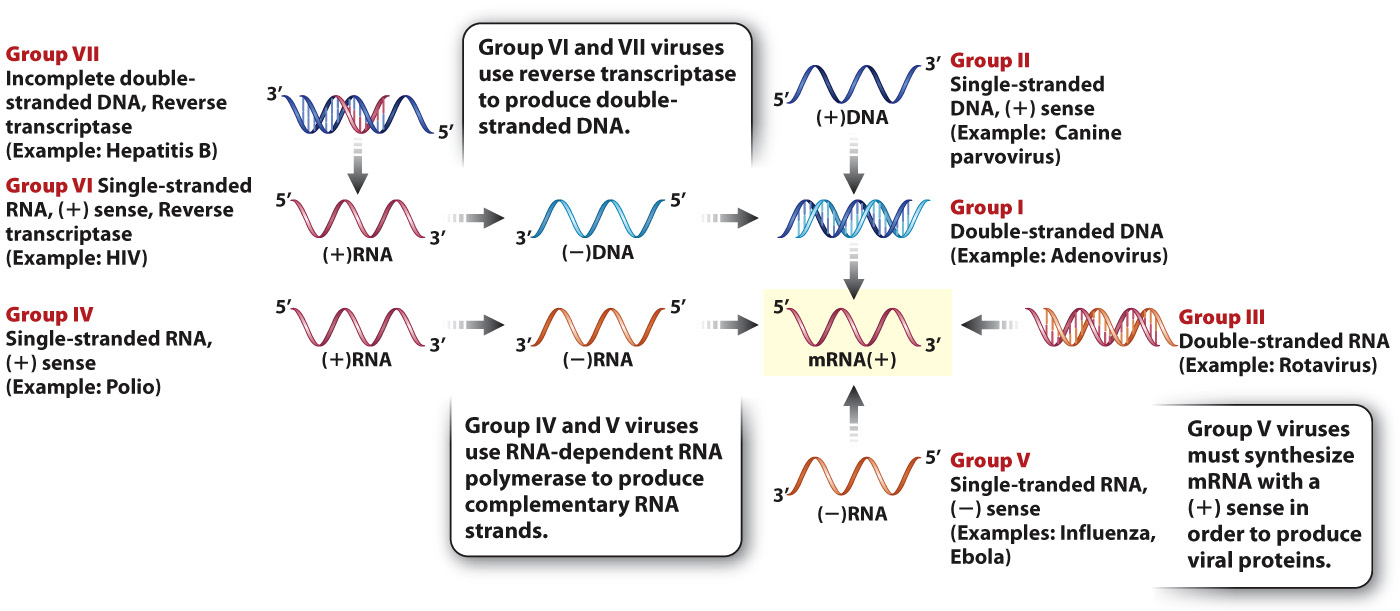Viruses can be classified by their genomes.
The genomes of viruses are diverse. Some genomes are composed of RNA and others of DNA. Some are single stranded, others are double stranded, and still others have both single- and double-stranded regions. Some are circular and others are made up of a single piece or multiple linear pieces of DNA (called linear and segmented genomes, respectively).
Unlike forms of cellular life, there is no evidence that all viruses share a single common ancestor. Different types of virus may have evolved independently more than once. Since classification of viruses based on evolutionary relatedness is not possible, other criteria are necessary. One of the most useful classifications is the type of nucleic acid the virus contains and how the messenger RNA, which produces viral proteins, is synthesized. The classification is called the Baltimore system after David Baltimore, who devised it.
According to the Baltimore system, there are seven major groups of viruses, designated I–VII, as shown in Fig. 13.16. These groups are largely based on whether their nucleic acid is double-stranded DNA, double-stranded RNA, partially double-stranded and partially single-stranded, or single-stranded RNA or DNA with a positive (+) or negative (–) sense. The sense of a nucleic acid molecule is positive if its sequence is the same as the sequence of the mRNA that is used for protein synthesis, and negative if it is the complementary sequence. For example, a (+)RNA strand has the same nucleotide sequence as the mRNA, whereas a (–)RNA strand has the complementary sequence. Similarly, a (+)DNA strand has the same sequence as the mRNA, and a (–)DNA strand has the complementary sequence (except that U in RNA is replaced with T in DNA). Because mRNA is synthesized from a DNA template, it is the (–)DNA strand that is used for mRNA synthesis (Chapter 3).

FIG. 13.16 The Baltimore system of virus classification. This system classifies viruses by type of nucleic acid and the way mRNA is produced.
Two groups synthesize mRNA by the enzyme reverse transcriptase, and therefore are placed into their own groups (VI and VII). Reverse transcriptase is an RNA-dependent DNA polymerase that uses a single-stranded RNA as a template to synthesize a DNA strand that is complementary in sequence to the RNA (Fig. 13.16). The reverse transcriptase then displaces the RNA template and replicates the DNA strand to produce a double-stranded DNA molecule that can be incorporated into the host genome. In synthesizing DNA from an RNA template, the enzyme reverses the usual flow of genetic information from DNA to RNA. This capability is so unusual and was so unexpected that many molecular biologists at first doubted whether such an enzyme could exist. Finally the enzyme was purified and its properties verified, for which its discoverers, Howard Temin and David Baltimore, were awarded the Nobel Prize in Physiology or Medicine in 1975, shared with Renato Dulbecco.
As we saw earlier, genome size varies greatly among different viruses. RNA viral genomes tend to be smaller than DNA viral genomes. Most eukaryotic viruses that have RNA genomes and most plant viruses, including tobacco mosaic virus, are in group IV. Among bacterial and archaeal viruses, most genomes consist of double-stranded DNA.
